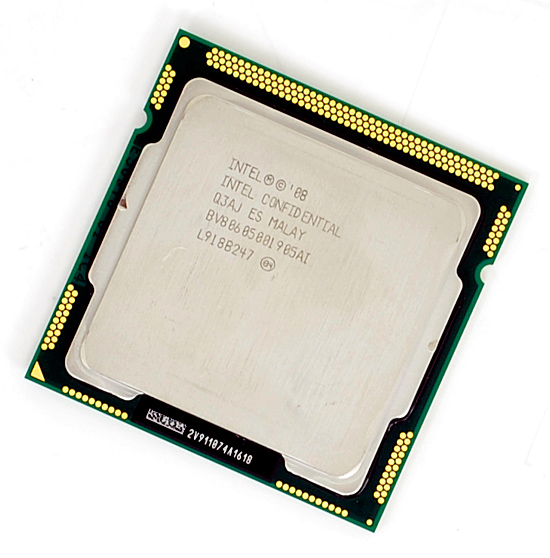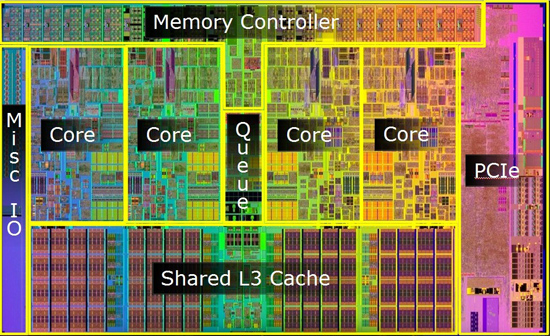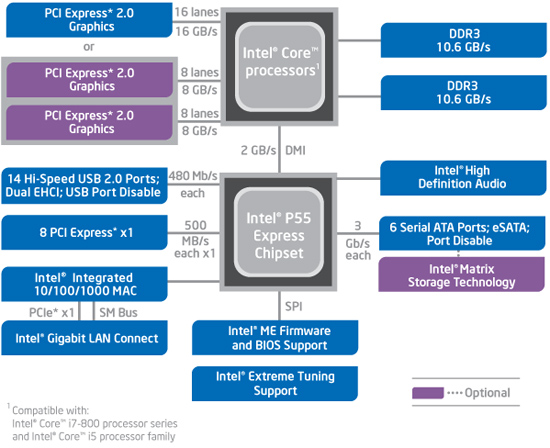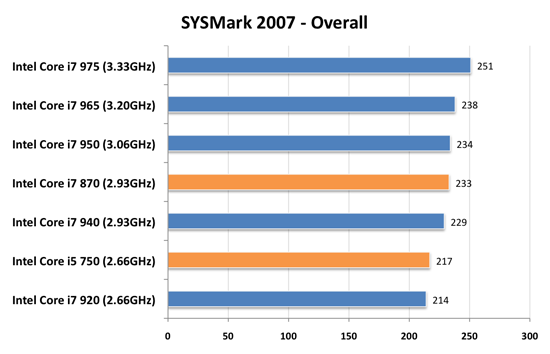Intel's Core i7 870 & i5 750, Lynnfield: Harder, Better, Faster Stronger
by Anand Lal Shimpi on September 8, 2009 12:00 AM EST- Posted in
- CPUs
Intel is on the verge of transitioning to 32nm. We'll see the first parts this year. What do you do with your 45nm fabs when you start moving volume away from them? Make really cheap quad-core Nehalems of course:

I'm talking $196. I'm talking faster than AMD's entire lineup. I'm talking about arguably the best processor of 2009. I'm talking about Lynnfield, and here's its backside:

Mmm
I spent much of the past year harping on AMD selling Nehalem-sized Phenom IIs for less than Intel sold Nehalems. With Lynnfield, Intel actually made Nehalem even bigger all while driving prices down. Like I said, what do you do when you're still making boatloads of money in a recession and are about to start emptying your 45nm fabs?
I should clear things up before we progress much further. Lynnfield is the codename for mainstream 45nm quad-core Nehalem, while Bloomfield refers to the first Nehalem launched at the end of 2008:
| Processor | Manufacturing Process | Die Size | Transistor Count | Socket |
| Bloomfield | 45nm | 263 mm2 | 731M | LGA-1366 |
| Lynnfield | 45nm | 296 mm2 | 774M | LGA-1156 |
Despite being cheaper, Lynnfield is larger than Bloomfield. The larger die is due to one major addition: an on-die PCIe controller.

Bloomfield, The First Nehalem, circa 2008

Lynnfield, Nehalem for All, circa 2009
The pink block to the right of the die is the PCIe controller, that's 16 PCIe 2.0 lanes coming right off the chip. Say hello to ultra low latency GPU communication. You'd think that Intel was about to enter the graphics market or something with a design like this.
Sacrifices were made to reduce CPU, socket and board complexity. Gone are the two QPI links that each provided 25.6GB/s of bandwidth to other CPUs or chips on the motherboard. We also lose one of the three 64-bit DDR3 memory channels, Lynnfield only has two like a normal processor (silly overachieving Bloomfield).

Intel's Bloomfield Platform (X58 + LGA-1366)
The sum is that Lynnfield is exclusively single-socket; there will be no LGA-1156 Skulltrail. While the dual-channel memory controller isn't really a limitation for quad-core parts, six and eight core designs may be better suited for LGA-1366.

Intel's Lynnfield Platform (P55 + LGA-1156)
The loss of QPI means that Lynnfield doesn't have a super fast connection to the rest of the system, but with an on-die PCIe controller it doesn't matter: the GPU is fed right off the CPU.
The Lineup
We get three Lynnfield CPUs today: the Core i7 870, Core i7 860 and the Core i5 750. Intel's branding folks told us that the naming would make sense one we saw the rest of the "Core" parts introduced; yeah that was pretty much a lie. At least there aren't any overlapping part numbers (e.g. Core i5 860 and Core i7 860).
The i7 in this case denotes four cores + Hyper Threading, the i5 means four cores but no Hyper Threading. The rules get more complicated as you bring notebooks into the fray but let's momentarily bask in marginal simplicity.
| Processor | Clock Speed | Cores / Threads | Maximum Single Core Turbo Frequency | TDP | Price |
| Intel Core i7-975 Extreme | 3.33GHz | 4 / 8 | 3.60GHz | 130W | $999 |
| Intel Core i7 965 Extreme | 3.20GHz | 4 / 8 | 3.46GHz | 130W | $999 |
| Intel Core i7 940 | 2.93GHz | 4 / 8 | 3.20GHz | 130W | $562 |
| Intel Core i7 920 | 2.66GHz | 4 / 8 | 2.93GHz | 130W | $284 |
| Intel Core i7 870 | 2.93GHz | 4 / 8 | 3.60GHz | 95W | $562 |
| Intel Core i7 860 | 2.80GHz | 4 / 8 | 3.46GHz | 95W | $284 |
| Intel Core i5 750 | 2.66GHz | 4 / 4 | 3.20GHz | 95W | $196 |
Keeping Hyper Threading off of the Core i5 is purely done to limit performance. There aren't any yield reasons why HT couldn't be enabled.
Intel was very careful with both pricing and performance of its Lynnfield processors. I'm going to go ahead and say it right now, there's no need for any LGA-1366 processors slower than a Core i7 965:

This is only one benchmark, but it's representative of what you're about to see. The Core i7 870 (LGA-1156) is as fast, if not faster, than every single LGA-1366 processor except for the ones that cost $999. Its pricing is competitive as well:

For $196 you're getting a processor that's faster than the Core i7 920. I'm not taking into account motherboard prices either, which are anywhere from $50 - $100 cheaper for LGA-1156 boards. I don't believe LGA-1366 is dead, but there's absolutely no reason to buy anything slower than a 965 if you're going that route.










343 Comments
View All Comments
jonup - Tuesday, September 8, 2009 - link
Unfortunately people in corporate world do not make a difference between a HD4500 and a GX790. As lond as the Intel can display spreadsheets its good enough (or better) than a GTX295/HD4890X2, because it is Intel. You can change ignorance when it works.PassingBy - Tuesday, September 8, 2009 - link
My horizons are broad enough, thank you. The needs of many corporate desktops/laptops will be met by Clarkdale/Arrandale and no, nobody will go blind or suffer eyestrain (by virtue of the IGP anyway).PassingBy - Tuesday, September 8, 2009 - link
No edit function, so, as I point out later in the thread, people reading this review presumably won't be interested in IGPs anyway, given that these processors now have no IGP market. Wait for Clarkdale before trying to compare IGPs.dragunover - Tuesday, September 8, 2009 - link
Thanks for the review, if not as soon as I wanted it!Boobs McGee - Tuesday, September 8, 2009 - link
Do you guys have plans to do a motherboard review roundup for P55?If not, please do.
Gary Key - Tuesday, September 8, 2009 - link
I actually have three roundups planned, we have 15 boards here ranging from the $100 uATX items up to the $300 EVGA Classified series. We are only testing with retail products, released BIOS', and retail processors so the delivery of more than 70% of the boards late last week has created a small logjam. ;)The first article should be up on Thursday with a couple of my favorite boards and then a rather large one up on Monday and the last one a few days after that. Raja is working on a separate roundup of the top three boards targeted for the more extreme OC community. We will also have a P55 memory specific article shortly.
ClagMaster - Tuesday, September 8, 2009 - link
Looking forward to reading these P55 motherboard roundups.Anand Lal Shimpi - Tuesday, September 8, 2009 - link
Yes, Gary is nearly complete with his. Give him another day and it'll be up :)Take care,
Anand
Comdrpopnfresh - Tuesday, September 8, 2009 - link
By creating a new socket- they're providing a disincentive for early adopters of bloomfield. This chip is literally a humpty-dumpty that stands to benefit intel with everyone suffering a small loss of their own. The benefits of lynnfield vs bloomfield come from shuffling the architectural deck of nehalem. In reality, it only shows the possibilities of an inflexible architecture.The turbo mode isn't cutting it in day-to-day power consumption reduction. On the scale of a day, the average shmoe who is ass enough to leave a computer on for no reason gains no benefit. Lower the reach of a voltage plane, and reduce the number of components sucking juice, that only present benefits under certain situations (a third memory channel), and shmoe is happier.
If it was in the article, I apologize, but with the pci-e controller being on the un-core... what happens on a chipset with integrated graphics? Will the igp be linked to the processor now, rather than a bridge chip? If ati or nvidia made their own supporting chipsets with an igp- would the igp represent a chip onto itself, solely connected to the cpu, or would it have to work through dmi, and leave those on-die pci-e lanes for domestic usage?
It seems this is the warning rattle to nvidia that they chose their place with ion, and are stuck in it. When the change to 32nm comes, and the gpu is integrated into the cpu- what kind of robust 3rd party chipsets could exist in the budget end? Sure, you can always add a dedicated, off-die, gpu... but for budget boards used to eons of making room for a cpu and working a bridge chip around an igp- either horrible inefficiencies will creep up, or higher prices.
My money is on westmere having at least three power planes.
I'd like to know: with the pci-e controller on-die now... what impact this puts on graphics cards with higher on-card memory. Does it strengthen or minimalize it?
And, can the cpu now share the gpu's memory as a way to extend cache- after years of being forced to share the system pool. That 16gb/s link to gddr5 looks mouthwatering. I'd like to see performance tests run with the pci-e varient ssds floating around out there saddled to the on-die pci-e lanes, and a graphics card running off of chipset. Rather than elevating a horse-power driven graphics subsystem, I think the benefits of supplying more 'torque' by freeing mass storage ssds from the SATA interface would be far more substantial, and in all applications of the PC. You already have the means for nearly 2+2/3 times the theoretical bandwidth of SATA-6- which up til now seems rather bug-ridden and defunct.
Also interested in the outcomes of usb3 with this- as usb is built on the foundations of pci-e, is it not? If usb3 can allow for pci-e externally, and you remove the latency issue of usb signaling traveling from some peripheral bridge chip to the cpu, and just jack the usb3 communications into the cpu... could one use usb3 as a computer-to-computer psuedo qpi teaming/networking bridge for inter-desktop cpu communication. skip the entire bottleneck of client-level software implementation, and the subsystem communication buses for out-of-box signaling too...
plague911 - Tuesday, September 8, 2009 - link
The market just got a little more crowded so hopefully this will bring a reduction in prices of the 920. but..
“The Core i7 870 gets close enough to the Core i7 975 that I'm having a hard time justifying the LGA-1366 platform at all. As I see it, LGA-1366 has a few advantages:
1) High-end multi-GPU Performance
2) Stock Voltage Overclocking
3) Future support for 6-core Gulftown CPUs
“
Your exactly right 1366 I think is going to be be the best option to “future proof” my system however the new chips make the 920- seem a little low on features. With the goal of “performance on a budget” I feel like we are stuck either getting a board with a socket which wont compete in the future, or chip which is weaker than its lower class cousins. Unfortunately I dont see any of this being fixed in the next few cycles. Id like to see a low clocked gulftown (to save cost) feature rich with good OC potential thats on the lower end of the price scale. To me this would be a good follow up to 920 but but it dosent seem like that will be coming out for several cycles. Unless ofc i'm missing something which is probably the case.